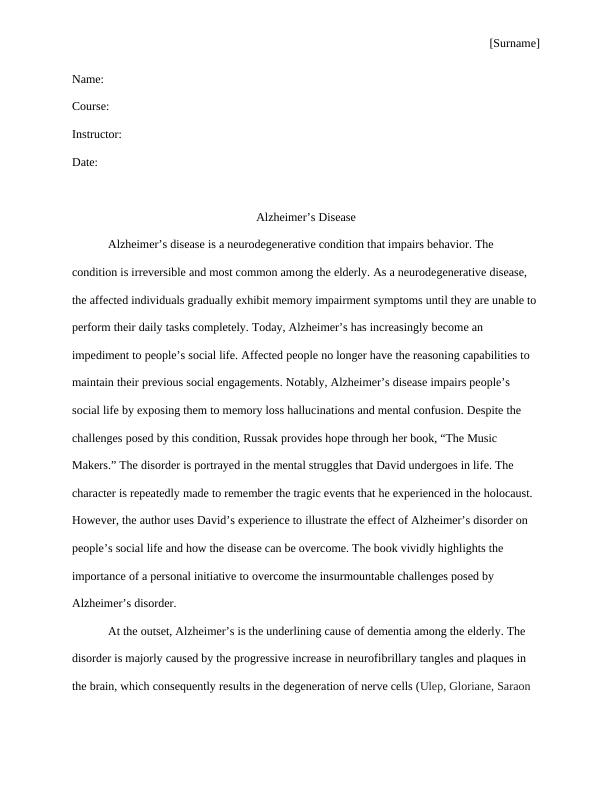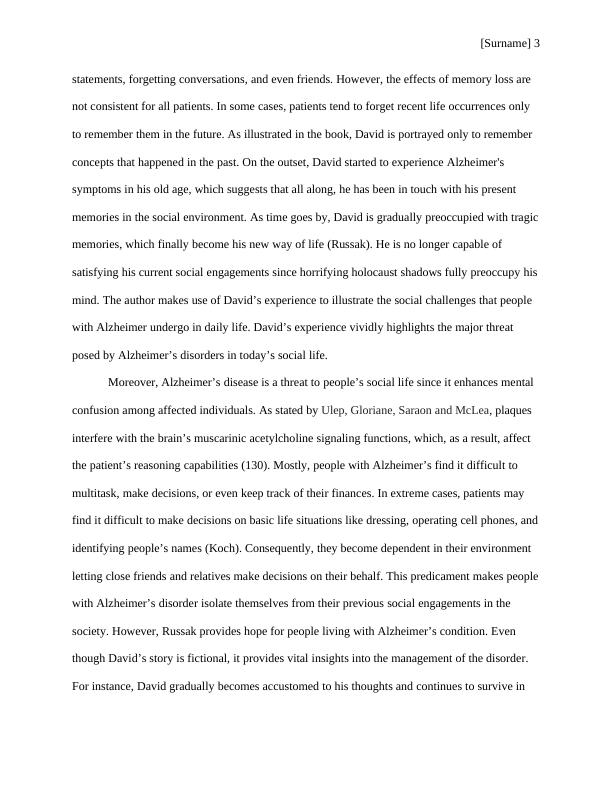Alzheimer’s Disease Case Study 2022
Added on 2022-09-26
7 Pages2087 Words21 Views
[Surname]
Name:
Course:
Instructor:
Date:
Alzheimer’s Disease
Alzheimer’s disease is a neurodegenerative condition that impairs behavior. The
condition is irreversible and most common among the elderly. As a neurodegenerative disease,
the affected individuals gradually exhibit memory impairment symptoms until they are unable to
perform their daily tasks completely. Today, Alzheimer’s has increasingly become an
impediment to people’s social life. Affected people no longer have the reasoning capabilities to
maintain their previous social engagements. Notably, Alzheimer’s disease impairs people’s
social life by exposing them to memory loss hallucinations and mental confusion. Despite the
challenges posed by this condition, Russak provides hope through her book, “The Music
Makers.” The disorder is portrayed in the mental struggles that David undergoes in life. The
character is repeatedly made to remember the tragic events that he experienced in the holocaust.
However, the author uses David’s experience to illustrate the effect of Alzheimer’s disorder on
people’s social life and how the disease can be overcome. The book vividly highlights the
importance of a personal initiative to overcome the insurmountable challenges posed by
Alzheimer’s disorder.
At the outset, Alzheimer’s is the underlining cause of dementia among the elderly. The
disorder is majorly caused by the progressive increase in neurofibrillary tangles and plaques in
the brain, which consequently results in the degeneration of nerve cells (Ulep, Gloriane, Saraon
Name:
Course:
Instructor:
Date:
Alzheimer’s Disease
Alzheimer’s disease is a neurodegenerative condition that impairs behavior. The
condition is irreversible and most common among the elderly. As a neurodegenerative disease,
the affected individuals gradually exhibit memory impairment symptoms until they are unable to
perform their daily tasks completely. Today, Alzheimer’s has increasingly become an
impediment to people’s social life. Affected people no longer have the reasoning capabilities to
maintain their previous social engagements. Notably, Alzheimer’s disease impairs people’s
social life by exposing them to memory loss hallucinations and mental confusion. Despite the
challenges posed by this condition, Russak provides hope through her book, “The Music
Makers.” The disorder is portrayed in the mental struggles that David undergoes in life. The
character is repeatedly made to remember the tragic events that he experienced in the holocaust.
However, the author uses David’s experience to illustrate the effect of Alzheimer’s disorder on
people’s social life and how the disease can be overcome. The book vividly highlights the
importance of a personal initiative to overcome the insurmountable challenges posed by
Alzheimer’s disorder.
At the outset, Alzheimer’s is the underlining cause of dementia among the elderly. The
disorder is majorly caused by the progressive increase in neurofibrillary tangles and plaques in
the brain, which consequently results in the degeneration of nerve cells (Ulep, Gloriane, Saraon

[Surname] 2
and McLea 129). Once the brain cells degenerate, the affected patient may exhibit symptoms
such as forgetfulness, mental confusion, memory loss, and poor judgment. Since the
aforementioned symptoms are central to people’s interaction in society, it is worth stating that
Alzheimer’s has detrimental effects on social life.
To begin with, Alzheimer’s impairs people’s social life through hallucinations. This
concept is portrayed in the book, where David gradually loses his touch with current events. The
tragic images of the holocaust repeatedly torment the character until he loses his focus. In the
process, David no longer has the cognitive capability to enjoy the social engagements in his
environment. He gradually becomes a prisoner of his past experiences. The author describes the
character as a person tormented by horrible images of the war (Russak). In his hallucinations,
David envisions himself in the middle of the holocaust, where innocent people are being
butchered under his watch (Russak). However, the author makes use of David’s tragic
experience to enlighten the society of how Alzheimer’s symptoms make people lose their touch
with the environment. As corroborated by Koch, Alzheimer’s makes people forget conversations,
repeat statements, and even get lost in their familiar locations. The book has managed to
illustrate how the concepts mentioned above are made possible through hallucinations. Notably,
David forgets his social surroundings because tragic images of the holocaust preoccupy his mind.
Furthermore, Alzheimer’s disorder impedes people’s social life by exposing them to
memory loss. Occasionally, people who have Alzheimer’s exhibit irreversible memory lapses,
which progressively worsen unless early clinical interventions are made. The condition is
majorly instigated by increased growth of intracellular neurofibrillary and plaques, which
contribute to neuronal death (Ulep, Gloriane, Saraon and McLea 129). As brain cells gradually
degenerate, so is the loss of memory. As a result, the patient may start repeating verbal
and McLea 129). Once the brain cells degenerate, the affected patient may exhibit symptoms
such as forgetfulness, mental confusion, memory loss, and poor judgment. Since the
aforementioned symptoms are central to people’s interaction in society, it is worth stating that
Alzheimer’s has detrimental effects on social life.
To begin with, Alzheimer’s impairs people’s social life through hallucinations. This
concept is portrayed in the book, where David gradually loses his touch with current events. The
tragic images of the holocaust repeatedly torment the character until he loses his focus. In the
process, David no longer has the cognitive capability to enjoy the social engagements in his
environment. He gradually becomes a prisoner of his past experiences. The author describes the
character as a person tormented by horrible images of the war (Russak). In his hallucinations,
David envisions himself in the middle of the holocaust, where innocent people are being
butchered under his watch (Russak). However, the author makes use of David’s tragic
experience to enlighten the society of how Alzheimer’s symptoms make people lose their touch
with the environment. As corroborated by Koch, Alzheimer’s makes people forget conversations,
repeat statements, and even get lost in their familiar locations. The book has managed to
illustrate how the concepts mentioned above are made possible through hallucinations. Notably,
David forgets his social surroundings because tragic images of the holocaust preoccupy his mind.
Furthermore, Alzheimer’s disorder impedes people’s social life by exposing them to
memory loss. Occasionally, people who have Alzheimer’s exhibit irreversible memory lapses,
which progressively worsen unless early clinical interventions are made. The condition is
majorly instigated by increased growth of intracellular neurofibrillary and plaques, which
contribute to neuronal death (Ulep, Gloriane, Saraon and McLea 129). As brain cells gradually
degenerate, so is the loss of memory. As a result, the patient may start repeating verbal

[Surname] 3
statements, forgetting conversations, and even friends. However, the effects of memory loss are
not consistent for all patients. In some cases, patients tend to forget recent life occurrences only
to remember them in the future. As illustrated in the book, David is portrayed only to remember
concepts that happened in the past. On the outset, David started to experience Alzheimer's
symptoms in his old age, which suggests that all along, he has been in touch with his present
memories in the social environment. As time goes by, David is gradually preoccupied with tragic
memories, which finally become his new way of life (Russak). He is no longer capable of
satisfying his current social engagements since horrifying holocaust shadows fully preoccupy his
mind. The author makes use of David’s experience to illustrate the social challenges that people
with Alzheimer undergo in daily life. David’s experience vividly highlights the major threat
posed by Alzheimer’s disorders in today’s social life.
Moreover, Alzheimer’s disease is a threat to people’s social life since it enhances mental
confusion among affected individuals. As stated by Ulep, Gloriane, Saraon and McLea, plaques
interfere with the brain’s muscarinic acetylcholine signaling functions, which, as a result, affect
the patient’s reasoning capabilities (130). Mostly, people with Alzheimer’s find it difficult to
multitask, make decisions, or even keep track of their finances. In extreme cases, patients may
find it difficult to make decisions on basic life situations like dressing, operating cell phones, and
identifying people’s names (Koch). Consequently, they become dependent in their environment
letting close friends and relatives make decisions on their behalf. This predicament makes people
with Alzheimer’s disorder isolate themselves from their previous social engagements in the
society. However, Russak provides hope for people living with Alzheimer’s condition. Even
though David’s story is fictional, it provides vital insights into the management of the disorder.
For instance, David gradually becomes accustomed to his thoughts and continues to survive in
statements, forgetting conversations, and even friends. However, the effects of memory loss are
not consistent for all patients. In some cases, patients tend to forget recent life occurrences only
to remember them in the future. As illustrated in the book, David is portrayed only to remember
concepts that happened in the past. On the outset, David started to experience Alzheimer's
symptoms in his old age, which suggests that all along, he has been in touch with his present
memories in the social environment. As time goes by, David is gradually preoccupied with tragic
memories, which finally become his new way of life (Russak). He is no longer capable of
satisfying his current social engagements since horrifying holocaust shadows fully preoccupy his
mind. The author makes use of David’s experience to illustrate the social challenges that people
with Alzheimer undergo in daily life. David’s experience vividly highlights the major threat
posed by Alzheimer’s disorders in today’s social life.
Moreover, Alzheimer’s disease is a threat to people’s social life since it enhances mental
confusion among affected individuals. As stated by Ulep, Gloriane, Saraon and McLea, plaques
interfere with the brain’s muscarinic acetylcholine signaling functions, which, as a result, affect
the patient’s reasoning capabilities (130). Mostly, people with Alzheimer’s find it difficult to
multitask, make decisions, or even keep track of their finances. In extreme cases, patients may
find it difficult to make decisions on basic life situations like dressing, operating cell phones, and
identifying people’s names (Koch). Consequently, they become dependent in their environment
letting close friends and relatives make decisions on their behalf. This predicament makes people
with Alzheimer’s disorder isolate themselves from their previous social engagements in the
society. However, Russak provides hope for people living with Alzheimer’s condition. Even
though David’s story is fictional, it provides vital insights into the management of the disorder.
For instance, David gradually becomes accustomed to his thoughts and continues to survive in

End of preview
Want to access all the pages? Upload your documents or become a member.
Related Documents
HNB3209 - Report on Nursing and The Communitylg...
|12
|3009
|98
Care for Older People - Case Studylg...
|11
|3312
|26
These tangles and plaques in the brainlg...
|4
|792
|23
Nursing Case Study Analysis Assignmentlg...
|7
|1182
|444
Nursing Care Assignment | Dementia Care Assignmentlg...
|10
|2199
|115
Treatment of People with Dementia: Involuntary Movementlg...
|5
|1232
|296
